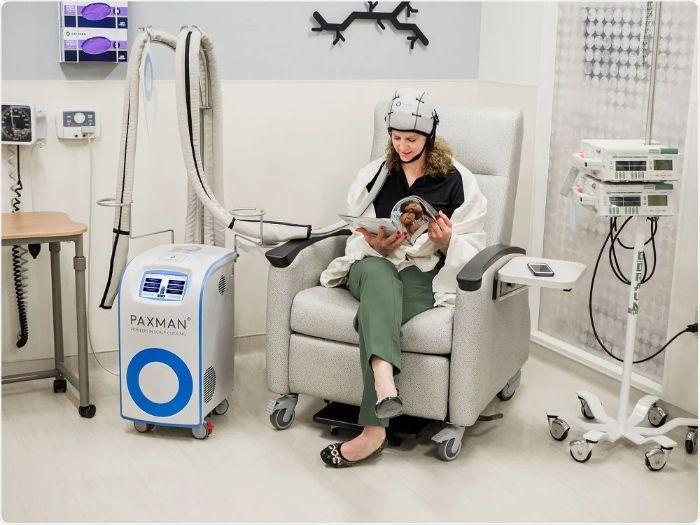Scalp Cooling System: Effective Method to Protect Chemotherapy Hair Loss

Chemotherapy is an effective cancer treatment method used to target fast-growing cancer cells. However, one of the common side effects of chemo is hair loss, as the medication cannot differentiate between healthy and cancerous cells. Scalp cooling works by constricting the blood vessels in the scalp, reducing the absorption of chemotherapy drugs into the hair follicles. When the levels of chemo in the scalp are lower, there is a much better chance of retaining some or all of the hair during and after treatment cycles.
Workings
Scalp cooling systems circulate coolant through a specially designed cap that is worn on the head during chemotherapy infusions. The cooling effect results in reduced blood flow to the scalp, which lowers the exposure of hair follicles to chemo drugs. Different systems regulate temperature differently - some maintain a constant cool temperature while others alternately cool and warm in cycles. The cooling treatment usually begins around 30 minutes before chemo infusion and continues for around an hour after treatment completion.
Effectiveness in Preventing Hair Loss
Studies have shown that scalp cooling can significantly reduce hair loss in many cancer patients undergoing chemotherapy. The effectiveness depends on various factors like type and dosage of chemo drugs, length of treatment, and individual patient characteristics. On average, scalp cooling helps 50-70% of patients retain some level of hair. For certain types of breast cancer chemotherapy with lower dose regimens, scalp cooling may help over 90% of patients avoid complete baldness. Even partial hair retention can make a huge psychological difference for patients dealing with cancer treatments.
No Guarantee but Reduces Risk
While scalp cooling improves chances of keeping the hair, it is not guaranteed to work for every patient and every type or dose of chemotherapy. Doctors cannot predict with certainty which individuals will respond positively. However, all available scientific evidence suggests that using a scalp cooling system lowers the risk of alopecia compared to not using it. Patients must understand this may not completely prevent hair loss but diligently following the cooling protocol maximizes benefits.
Safety of Scalp Cooling
Modern scalp cooling technology has been refined over the past few decades and is now considered very safe when administered properly by trained personnel. Risks of using an effective cooling system are quite low and usually limited to temporary adverse effects like headaches or local discomfort. No clinically significant risks to health or interference with chemotherapy efficacy have been reported. Children receiving chemotherapy can also benefit from scalp cooling with close monitoring by medical staff.
Cost Considerations
While scalp cooling provides practical and psychological benefits, not all cancer centers or health insurance plans cover the costs currently. Some patients have to pay out-of-pocket, which can be a financial barrier. Scalp cooling systems require maintenance and servicing too. Cost per session ranges from $50-250 depending on the technology used and treatment duration involved. More healthcare providers and insurers are recognizing its value, so coverage is improving gradually in many countries. Still, affordability remains an important factor when opting for scalp cooling.
Overall, scalp cooling offers chemotherapy patients a non-invasive option to significantly reduce risks of alopecia, helping preserve dignity and self-esteem during cancer treatment. When used correctly alongside standard medical therapies, it delivers tangible psychological benefits with minimal risks. Wider access and coverage would enhance quality of life for even more individuals undergoing chemotherapy.
Alternative Scalp Cooling Methods
In addition to specialized cooling devices, some alternative scalp cooling therapies are also gaining recognition:
Cold Caps: Made of a lightweight material like acrylic fabric, these caps are filled with a gel or liquid which needs to be refrigerated before each use. Cold caps maintain cooling for around 2 hours per session through direct scalp contact and cooling of blood vessels in the area.
Manual Ice Packs: Standard ice packs wrapped in soft material can be held gently against the head during chemo infusions. Though less controlled than regulated devices, simple ice therapy may provide some protection for dose-sensitive hair follicles.
Cold Garments: Tight-fitting skull caps or beanies made of compressive cold-activated gel or water-based fabrics can cool the scalp from outside. With frequent gel activation or replacement of cooling elements, these accessories offer portable scalp cooling anywhere.
Breathable natural fabrics become chilled when soaked in iced water and applied directly to the head has been used traditionally before modern cooling gear. Despite less scientific validation, many patients still favor low-cost DIY options as better than nothing. Overall, all methods aim to reduce chemo exposure to hair roots, lowering alopecia risks to some degree.
Priya Pandey is a dynamic and passionate editor with over three years of expertise in content editing and proofreading. Holding a bachelor's degree in biotechnology, Priya has a knack for making the content engaging. Her diverse portfolio includes editing documents across different industries, including food and beverages, information and technology, healthcare, chemical and materials, etc. Priya's meticulous attention to detail and commitment to excellence make her an invaluable asset in the world of content creation and refinement.
(LinkedIn- https://www.linkedin.com/in/priya-pandey-8417a8173/
- Art
- Causes
- Crafts
- Dance
- Drinks
- Film
- Fitness
- Food
- Oyunlar
- Gardening
- Health
- Home
- Literature
- Music
- Networking
- Other
- Party
- Religion
- Shopping
- Sports
- Theater
- Wellness
- IT, Cloud, Software and Technology


